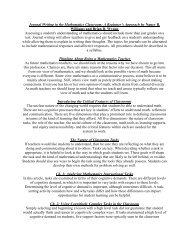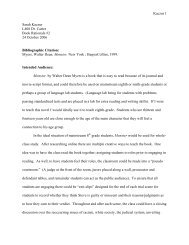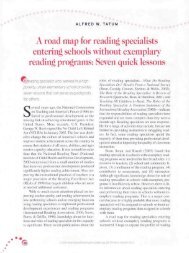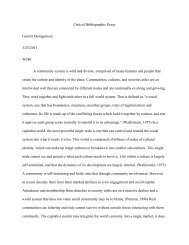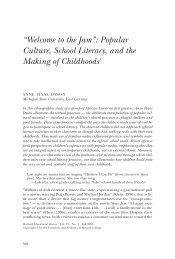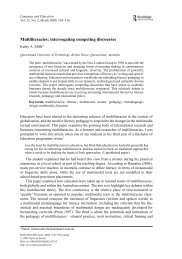Night. Night - Oncourse
Night. Night - Oncourse
Night. Night - Oncourse
You also want an ePaper? Increase the reach of your titles
YUMPU automatically turns print PDFs into web optimized ePapers that Google loves.
Kaczur 18<br />
Antisemitism was a familiar part of European political life in the 1800s. Political<br />
antisemitism was preceded by centuries of religious persecution of Europe's Jews. There is<br />
evidence as early as 1919 that Hitler had a strong hatred of Jews. As Chancellor and later<br />
ReichsfŸhrer, Hitler translated these intense feelings into a series of policies and statutes which<br />
progressively eroded the rights of German Jews from 1933-1939.<br />
At first, the Nazis boycotted Jewish businesses for one day in April 1933. Then legislation<br />
excluded Jews from certain professions. The Nuremberg Laws created very detailed Nazi<br />
definitions of who was Jewish. Many people who never considered themselves Jewish suddenly<br />
became targets of Nazi persecution.<br />
The world accessible to German Jews narrowed. Jews were no longer allowed to enter cinemas,<br />
theaters, swimming pools, and resorts. The publishing of Jewish newspapers was suspended.<br />
Jews were required to carry identification cards and to wear Star of David badges. On one night,<br />
Nazis burned synagogues and vandalized Jewish businesses. The arrests and murders that<br />
followed intensified the fear Jews felt. Next, Jewish children were barred from schools. Curfews<br />
restricted Jews' time of travel and Jews were banned from public places. Germany began to expel<br />
Jews from within its borders.<br />
Germany's invasion of Poland in late 1939 radicalized the Nazi regime's policy toward Jews.<br />
Hitler turned to wholesale death of the European Jewish population. He swept Jewish<br />
populations into ghettos in eastern Europe. Simultaneously, mobile squads killed millions. The<br />
next step was to send Jews to squalid concentration and death camps. Approximately six million<br />
died for one reason: they were Jewish.<br />
More information about Jewish victims of the Holocaust, with links to other Web sites<br />
and documentary materials.<br />
Roma (Gypsies)<br />
The Roma, a nomadic people believed to have come originally from northwest India, consisted<br />
of several tribes or nations. Most of the Roma who had settled in Germany belonged to the Sinti<br />
nation. The Sinti and Roma had been persecuted for centuries. The Nazi regime continued the<br />
persecution, viewing the Roma both as asocial and as racially inferior to Germans.<br />
Although the Nuremberg Laws did not specifically mention them, Roma were included in the<br />
implementation of the statutes. Like Jews, they were deprived of their civil rights. In June 1936,<br />
a Central Office to "Combat the Gypsy Nuisance" opened in Munich. By 1938, Sinti and Roma<br />
were being deported to concentration camps.<br />
The fate of the Romani peoples paralleled that of the Jews after the beginning of World War II:<br />
systematic deportation and murder. First, western European Roma were resettled in ghettos.<br />
Then they were sent to concentration and extermination camps. Many Roma in the east--Russia,




